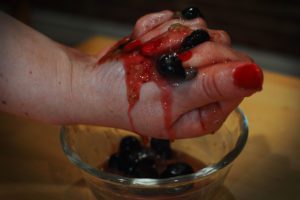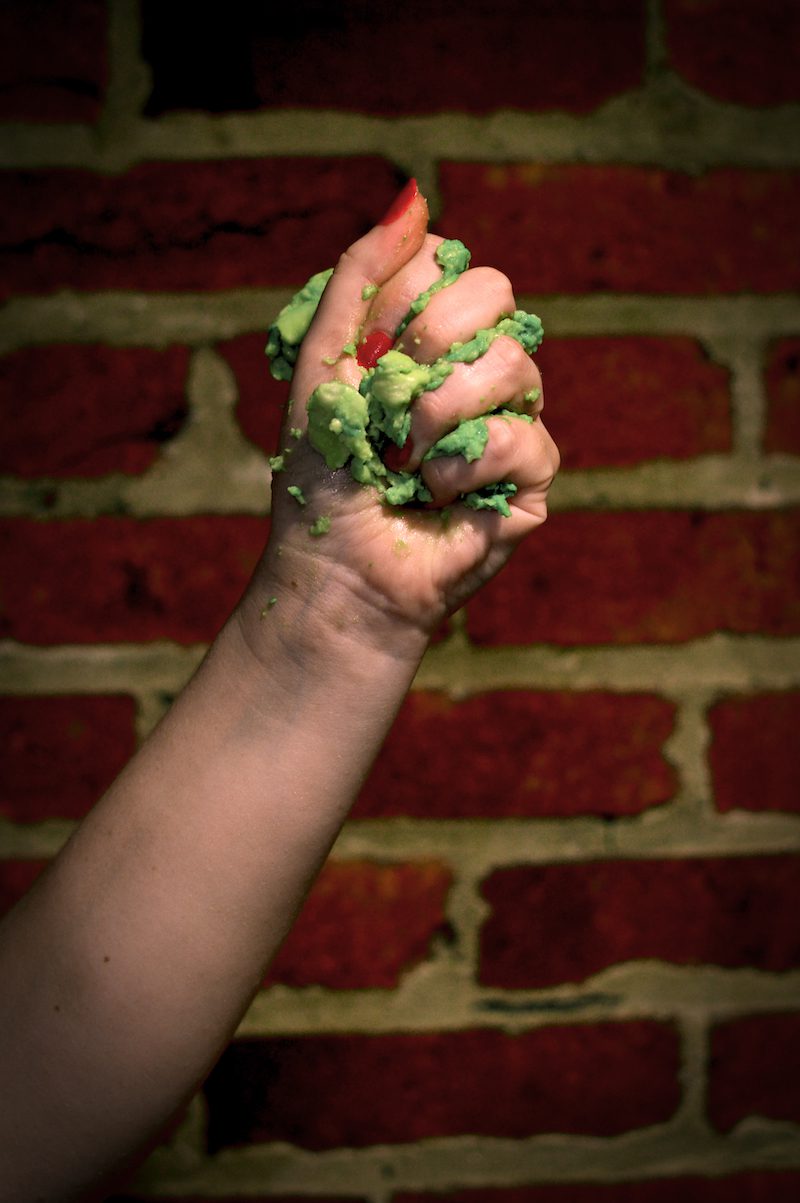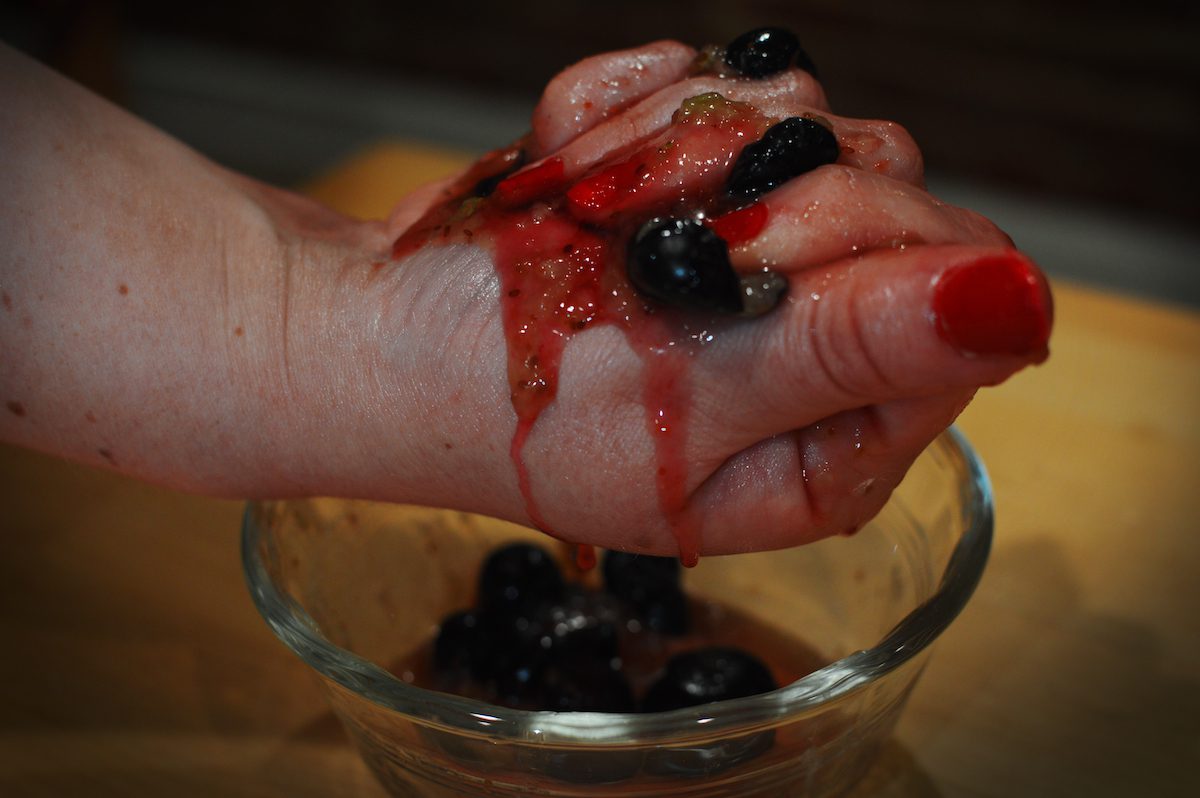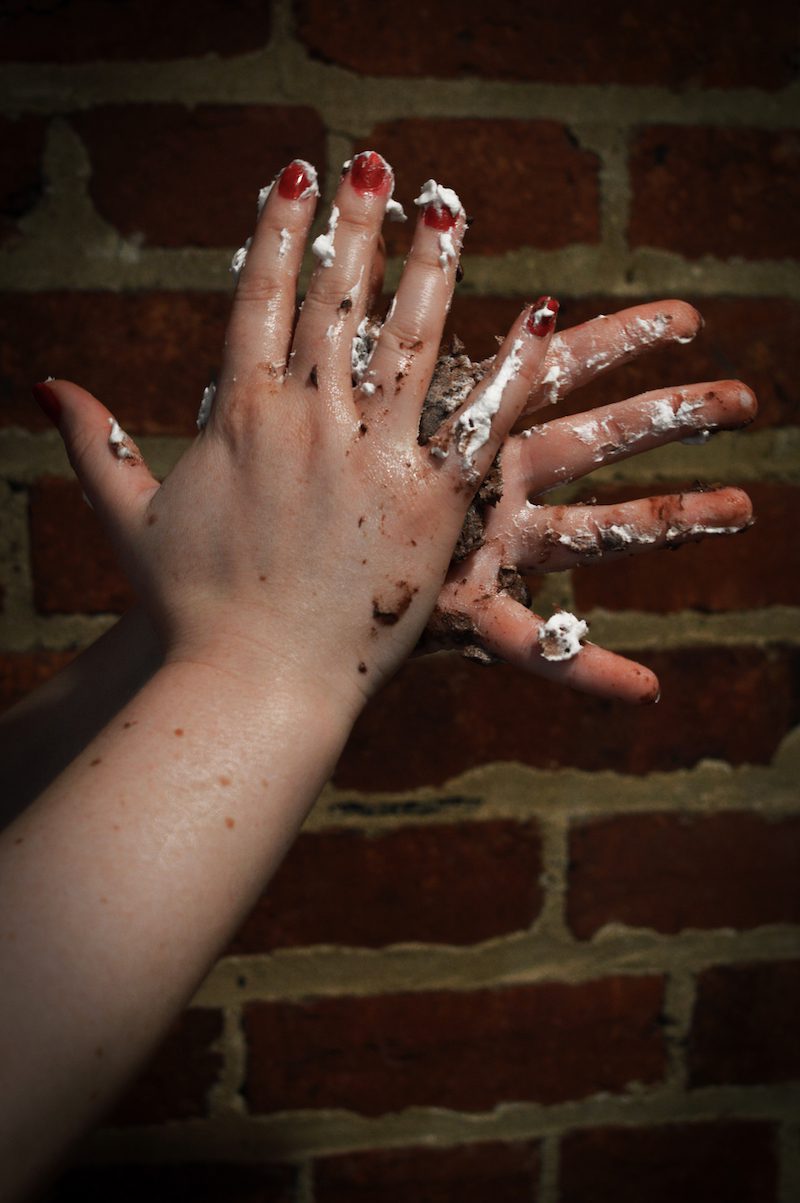
Pre-pandemic, my husband was always meeting new women. These women worked as food and prop stylists and assistants to food and prop stylists on the sets where my husband was the photographer. The women shop for and cook the food that he photographs for a food and lifestyle website. On occasion, when he shoots as a freelancer for fashion magazines, different women source and arrange backgrounds, use wax and thread to style fabrics to achieve the perfect fold. Sometimes the stylists are men, but ninety percent of the time they are women. Their jobs are utterly female: invisible, indispensable labor, often uncredited and largely unknown.
When the day’s shoot ends, the women who make and style the food and the “soft goods” clean everything––the dishes, the linen––and put them away. If the crew has eaten the food they cooked, the women clean their dishes, too. Once, early in his career, my husband told me, he took his dirty plate to the sink to wash it, and one of the women rushed in and took it from him. Here, she said, wait, stop, don’t. As if saving him from a terrible faux pas. Let me do that.
Sometimes these women lend a hand to the photos. Not as parts models, though he’s shot those, too, but as the everyday person whose body gets used in the photograph to demonstrate action or display an object: the hand peeling garlic, unsheathing a knife, squirting dish soap. These anonymous body parts populate our visual culture, showing us what “happy” or “powerful” or “woman” looks like; they model how-to banalities like food preparation, house cleaning, and pet care. These bodies are seen so frequently as to be invisible, yet at the same time mark the visual boundaries of acceptable public flesh. They constitute what visual culture scholar Paul Frosh terms “the wallpaper of consumer culture.”
Now, because of the virus, we both work from home, and the only disembodied body parts my husband can use for his photographs are mine. My hands––until now mostly used for typing, cooking, holding our daughter––my hands are now demonstrating how to clean a drain, wash a pan, hold a cookbook. My brain––until now, at the best of times, used for thinking and writing, chiefly about books and photography, as a professor of journalism in a mountain college town––my brain is now used primarily to entertain our four-year-old without play dates, school, museums, libraries, playgrounds, grandparents, friends. At home, as I become the not-subject subject of my husband’s photographs, I have become the embodiment of what art historian John Berger observed, and what I teach college students in my course on images: Men act. Women appear.
When my husband told me he’d need my hands I first thought he meant as an assistant––someone to move around the lights, hold the umbrella, extend the tripod. Work that I don’t know how to do, and that at seven months pregnant felt uniquely unequipped to perform. At the same time, with our second baby on the way and media jobs vaporizing overnight, I felt determined to figure it out; we needed that job. But then he said, No, no. I mean that literally. I am going to need your hands.
“Who usually does this for you?” I’d asked.
This colleague, that one. Always a woman with a professional manicure. I looked at pictures he’d taken that showed his colleagues’ arms and hands: Headless, disembodied H, whose nails are always painted a fun color, like pastel purple. S’s fingers show off involved nail art, the kind of expensive, labored manicure that requires more than half an hour of sitting still––evidence of richness in time and money. The tops of their hands are smooth, almost veinless. Their skin is light, without visible arm hair. They are invisible and therefore acceptable. Of a piece, all are slim.
Before he was the photographer, when he was an assistant, my husband’s body was once drafted for this purpose. His arm––heavily freckled and covered with downy brown hair––subsequently appeared in a photograph in a popular newsweekly.
We got our first glimpse of the photograph at a rest area on the thruway, where the magazine was displayed prominently. That’s my arm! He’d told the cashier.
You’re famous! she’d said, not being ironic.
It was so exciting but also felt cheap and strange: that was his arm, but it appeared without mention or credit or even extra money for being his. His arm was meant to seem “almost deliberately unremarkable and inconspicuous,” as Frosh, the visual culture scholar, writes about stock photos. It was meant to be forgettable, a prop for the glob of ice cream spilled on his wrist.
Among the great ironies of becoming my husband’s mannequin is that I have built my academic career studying photographs. I focus on the way we use them in journalism to commemorate the past, from 9/11 to the Berlin Wall to the Holocaust’s aftermath. I read these visual “public memories” for what’s not shown––the silences and omissions that manifest because of “what editors and journalists believe legitimately belongs within the public domain,” as media researchers Kurt Lang and Gladys Engel Lang write. I research what, on anniversaries, doesn’t make it into the public sphere––like graphic photographs from 9/11, or images of Jewish people defending themselves during World War II, and, too often, no matter the “anniversary,” people of color.
It’s hard to see what isn’t there. You have to look periscopically, using (metaphoric) mirrors and prisms to discover what’s impossible to see straight-on––a research method conceived by feminist geographer Nancy Hiemstra for investigating places otherwise “obstructed from view.” These omissions are often more authentic, more interesting, sharper, more painful than the photographs that do run. For instance, when the mass media commemorates 9/11, it tends to show photographs of the planes hitting the towers, American flags, firehouses, the 9/11 Memorial’s reflecting pools. I’m sure you have that photo newsreel in your head. Equally, news organizations overlook the mess at the Pentagon, the plane that hit the ground in Pennsylvania, the bits of bone discovered around Lower Manhattan and in the Fresh Kills Landfill in the years that followed. These awkward, depressing, discomfiting images are largely filed in the vault of the forgotten; they are incompatible with the media’s insistence on valorizing 9/11 victims as heroes who died for American freedom. They don’t serve present aims, which as scholar Barbie Zelizer has asserted, is so much of what public memory does. In the case of 9/11, remembering victims as “heroes” justfies the war in Iraq and makes their deaths seem worthwhile, part of a larger cause, rather than random murder.
But the people who died on 9/11 didn’t necessarily think of themselves as American heroes. As one 9/11 widower recounted in Marita Sturken’s Tourists of History, “My wife was not a goddamn freedom fighter. All she was fighting for was a chance that we might move to a bigger apartment.”
The thing about using photographs to remember is that they are evidentiary: they document a real thing that was once in front of the camera. Thus Chinese authorities’ suppression of the photograph of the lone protester standing in front of tanks at Tiananmen Square. Without a photograph, it’s much harder to document that a past ever happened. Such is the authority of the camera.
The first shot was harder than it looked: I had to wear an apron embroidered with the company’s logo and hold up a cookbook. I thought it would take a minute, maybe two. It took about twenty minutes. It felt like work.
My husband fixed the apron on me. It was too long, bulky in the shoulders, tight across the bust and stomach. I held a cookbook in front of my body. We tried to disguise my pregnancy, which would be authentic (pregnant and barefoot in the kitchen) but off-brand for his company.
“It’s much easier to do this with you. Because I can touch you,” he said. Before the virus I’d begun writing about sexual and gendered harassment, another largely unseen part of the photographic industry. Like the male photographer who yelled “Girls on set!” when his female assistant arrived for the day. The well-known, married photographer with young children whom clients frequently ask, “So who’s watching the kids?” The veteran photojournalist introduced by her fixer as a “journalist lady” to authorities on the US/Mexico border.
My husband futzed with the apron some more. It felt nice to be this close to him. Since the stay-at-home order, we had been tag-teaming work and parenting, trading off shifts but not spending time together.
“What else is different about working with me?” I asked, fishing for a compliment.
“Can you hold that out more? Like in the center?” Now he was the photographer, and he spoke to me from behind the camera. He shoots tethered, which means that the photographs immediately show up on his laptop, so you have the opportunity to criticize yourself in a full-screen-size JPEG. In the photograph, one of my hands looked like a claw. “You’re doing something weird with your thumb. Can you hold it like this?” He moved my hand gruffly. Back behind the camera. “Down a little. A little more. Not that much. Better,” he said. “Hold it.”
“So what else is different?” I pressed again.
“What else is different?” he repeated. He pressed the shutter. “No one else wears a ring.”
John Berger asserted that although we expect photographs not to lie, in fact the work of advertising and publicity consists of “construct[ing] lies before the camera. A ‘tableau’ of objects and figures is assembled. This ‘tableau’ uses a language of symbols, an implied narrative and, frequently, some kind of performance by models with a sexual content.” Before COVID-19, the women my husband worked with set up the tableaux. Now, setup is up to my husband and my hands are among the assembled objects. And yet “human parts” are never listed by his colleagues among the “props needed” to make these photos. For cleaning a rug: dish soap, area rug, towel, soft brush, bucket, rag. Not included: a pair of hands to make them dance.
I quickly learn that the hardest part of my new job is that the way I naturally hold an object can easily look bizarre or even pornographic on camera. We laugh about these bloopers: a shot of “cleaning” a broom handle looks as if I’m jerking it off (maybe don’t caress it like that, my husband says); a microfiber cloth, my hand invisible beneath it, reads as a cartoonish ghost pressed against a window. Other angles emphasize the deep blue veins on the underside of my wrist, or make my fingers look gnarled (“Okay, start over; you have nice hands, let’s show them”). These comments make me a little nervous; he isn’t talking to me as my husband, has never spoken to me like that before, and I wonder if there are other parts of me that he appraises in such a detached way, because as a photographer he can’t help it. As if, like his camera, he has an all-seeing eye.
Other shoots are easy: grasp a baking sheet with pot holders as if it is hot from the oven; wipe clean a new-from-the-box toaster oven; rinse water in circles around a cast-iron pan. But even these simple shots take ages to set up. There is always so much pre-cleaning to do. This is another way in which my husband has become one of the women. Instead of showing up to a set that’s already cleaned, he washes the dishes, cleans the sink, the drain. He cleans the stovetop, the top shelf of the refrigerator, the ice-maker. He cleans the dining table so that it can look clean when I clean it for show. This cleaning also shows how inadequate we are, how inadequate our house is. Some dirt is too caked-in to come out, and we labor to pose my elbow to hide filthy caulk or the creeping mildew on the backsplash behind the sink, evidence that the guy we overpaid to redo the kitchen counters did a bad job––and further evidence of our inadequacy, our inability to prevent our home from going to seed. Like the dirt embedded so deeply into my cuticle, which I see zoomed in on my husband’s laptop during a shoot about making ice. I’d washed my fingernails for the shoot, had even shaped them with an emery board, but couldn’t get rid of the dirt.
“I can’t believe you can see that,” I tell him.
“I know,” he says. “The camera sees everything.”
Other stories are absurd. For one about how to clean broken glass, we press a slice of bread, and then half of a potato, into the shards of a mason jar we’ve shattered on the floor. The bread and the potato hug the shards so that you don’t cut your fingers or do what seems to me the logical thing: use a broom. It’s the day before Passover and the only bread we have in the house is half a loaf of homemade challah. It feels extravagant to be wasting homemade bread on this and also utterly fantastic to make forgettable illustrative photographs with challah, not white bread, to add genuine ethnicity to the digital visual economy. There is nothing contrived here, no pandering to an audience on Chanukah, the one Jewish holiday that the broader public recognizes: legit, on a Tuesday, this is the bread we have lying around the house. We have so much of it, the photo suggests, that we can basically just throw it away.
For another shoot I can almost touch the woman I am pretending to be: a person who uses a Swiffer, a Q-tip, a broom, a dishrag, and a Magic Eraser to clean a baseboard. It’s good this thing is dirty, my husband says, and I agree although actually I had cleaned the bathroom (and the baseboard) the day before. But I am secretly thrilled to learn about the Magic Eraser, which I hadn’t known existed. In fact, I am enchanted: perhaps this is the answer to my problems, to the layer of dust forever accumulated on all of our things that I can’t seem to eradicate, even when I put in my best efforts. Maybe the Magic Eraser shows that I’m not inadequate––only that I’ve been using the wrong tools. Maybe if I use it, I will change, too: become a more conscientious person, a better wife, more likely to pick up rather than step over (or on) the napkins or marker caps or socks or change that’s been left on the floor. It seems possible that my mastering the use of the Magic Eraser will also lead to accumulating other feminine skills, like knitting or using a sewing machine.
My husband takes the baseboard-cleaning photos from inside the bathtub, and bath toys fall around his legs. The minutes tick down on Sesame Street, our daughter’s electronic babysitter in the other room. But for twenty minutes I am somebody else, someone whose floor and baseboards look great, clean, as if no one really lives here.
Later, my husband shows me the photographs, and I am amazed at how convincing they are, how empty of our stress and labor. When they go out into the world they will silently add to what Paul Frosh describes as the “glossy, formulaic, multipurpose representations of consumer well-being and corporate achievement (smiling, white, middle-class families at the beach, well-groomed businessmen shaking hands),” which “simultaneously refle[ct] and reinscrib[e] cultural stereotypes.” But no one––seriously no one, my husband stresses, clicking through the photos on his computer––will look closely enough at the photographs to think about that. If website scrolling can be said to be looking at all.
Sometimes we shoot when our daughter is sleeping. We did this for a series on vacuuming, which included our bookcase, and for which my husband removed all of the kids’ books because they’d be too off-brand. It was 10 p.m. by the time the “setting,” as sociologist Erving Goffman wrote in his book on self-presentation, with its “furniture, decor, physical layout, and other… scenery and stage props” was ready for us to “begin [our] act.”
“Should I change?” I ask. I’m wearing the same leggings and ripped blue T-shirt I’ve been wearing for days. We look at the photo, the shredded hem a sad reminder of what you actually wear to clean the house. Too real.
“Don’t you have something with a subtle pattern?” he asks.
By this time I am thirty weeks pregnant. I am down to one bra that sort of fits with a bra extender. We live outside of New York and the supply chains are broken. Plus, I am too cheap to buy nice maternity clothes for our stay-at-home life. But I change anyway. This photograph shows my lower body, the however-many-pregnancy-pounds packed on to ensure a soft landing for baby. So I also put on a long cardigan to disguise this; I’m not too proud to be vain. Later I’ll see that his company is using this shot internally as a placeholder for photographs about cleaning; my body has become a bookmark “test shot.”
Before he takes the photographs, I play art director and stack titles that would never otherwise make it into the stock world: Tales of the Hasidim; a photo book published by a friend; Martin Gray’s For Those I Loved, a Holocaust story my father gave me several decades ago, its flame on the cover a stand-in for the Auschwitz crematoria, and that I still haven’t been able to read.
It’s true that no one would notice this. Such invisibility is the point of these photos, which are designed to seem like neutral representations––as if such fraught concepts as “home,” or “tidy,” or “labor” could ever be divorced from their ideological codes. But there’s a chance––a snowball’s chance––that someone like me, who looks at images from the side rather than dead on, would recognize what the art historian James Elkins asserted in the title of his book on seeing: sometimes, the object stares back.
***
Rumpus original art by Cassandra Osvatics.








